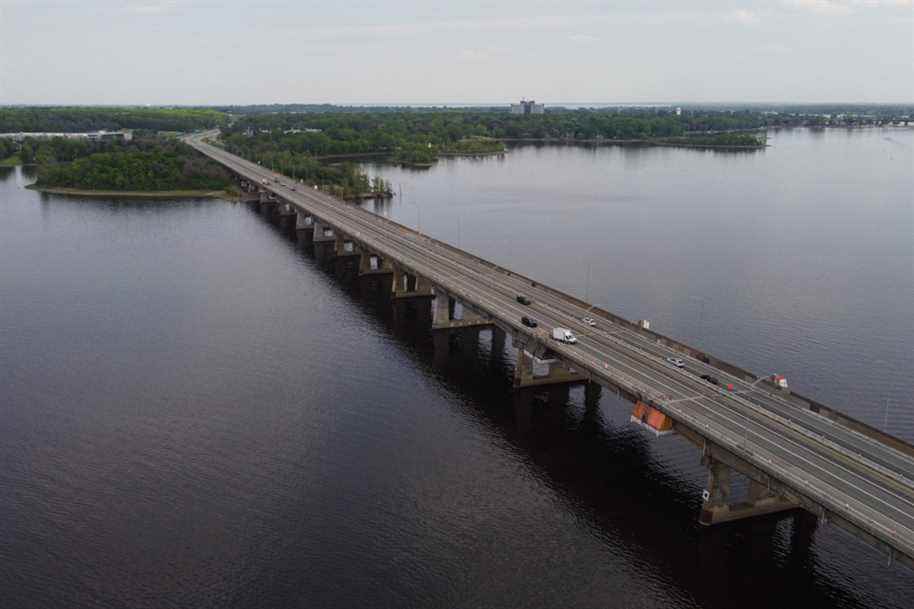In October, the Quebec government adopted an implementation decree for the construction of the new Île-aux-Tourtes bridge, which does not provide a reserved bus lane or structure to support a possible extension of the Metropolitan Express Network (REM) to the west of the island of Montreal.
The new bridge will be built just north of the current bridge, on Highway 40, between Vaudreuil and Senneville, at the western tip of the island of Montreal. It will be almost two kilometers long and consist of two separate decks, separated by about five meters. Each deck will have three lanes of traffic per direction – the same number as the current bridge – and wide shoulders on both sides of the carriageway. One of the decks will also have a bicycle path connected to local networks at both ends of the bridge.
The right shoulder will be four meters wide and can be used by buses to bypass traffic when there is congestion on the bridge.
This is called a use of the shoulder for buses. The Quebec Ministry of Transport (MTQ) has opted for this concept “for a better integration of public transport on the new infrastructure”.

IMAGE PROVIDED BY THE MINISTRY OF TRANSPORT
According to the current route, the REM will stop at Anse à l’Orme, 4 km east of the bridge. The station will be built on the north side of Highway 40, while the right-of-way reserved by the MTQ for a possible extension is located on the south side of the highway. The REM will therefore have to “jump” over the A40 at the level of the Anciens-Combattants interchange, if it ever needs to reach Vaudreuil.
In addition, “although the project does not include in its structure a track for the possible passage of a heavy rail transport mode, the MTQ has planned to keep a 10-meter corridor south of the future bridge for the potential establishment of an extension of the REM ”, according to the project’s environmental analysis report. This corridor will be created in the space cleared after the demolition of the current bridge.
There is currently no project to extend the REM towards Vaudreuil.
Three options discarded
At present, according to the analysis report, four bus lines of the exo network use the Île-aux-Tourtes bridge daily, at the rate of 148 daily passages, and carry a little more than 2,100 users of the public transport per day, in one direction or the other. There are no preferential measures in place on the bridge, or at the approaches, to encourage the circulation of buses, which travel with the rest of the vehicles. “This situation affects the level of service, in particular because of road congestion, upstream of the bridge, and road accidents that may occur on the bridge,” the report reads.
The MTQ chose the concept of using the shoulder for buses after analyzing three other options that “presented more significant disadvantages”.
The creation of a permanent reserved lane on the shoulder of four meters, to the right of the road, has been ruled out. One of the main causes of congestion on the current bridge comes from accidents that occur during peak periods and the lack of a shoulder wide enough to constitute a safe refuge area. Converting the shoulder to a reserved lane would limit significant fluidity gains for the new bridge.
The possibility of adding a fourth traffic lane reserved for public transit to each deck of the bridge was also studied. In addition to “significant costs”, its realization would have entailed complex connection work upstream of the bridge. In fact, such an addition appears disproportionate insofar as “there is no significant recurring congestion on this bridge”, even in the traffic projections for 2036.
The third option studied and discarded was to convert one of the three lanes of traffic, in each direction, to a reserved lane. Reducing car traffic to two lanes per direction would cause congestion at peak times and degradation for freight transport. To prevent this deterioration in traffic, the MTQ estimates that 30% of motorists who cross the bridge every day should change their mode of transport and swap their car in favor of buses, cycling or walking.
End of 2028, at best
Built in 1965, the Île-aux-Tourtes bridge is at the end of its useful life and is causing costly maintenance issues. No less than $ 150 million has been set aside by Quebec to maintain the current structure pending the construction of the new bridge. The project is the subject of a call for qualifications for consortia and companies interested in its construction, which will be followed by a call for proposals between the finalists.
The signing of the final contract is not expected before the spring of 2023, and the construction of the bridge will take at least five and a half years, and possibly up to a year more, depending on the scenarios presented by the builder. At best, the new bridge could be open to traffic before the end of 2028 or early 2029.
In numbers

IMAGE PROVIDED BY THE MINISTRY OF TRANSPORT
21
Number of piers of the new bridge that will be partially or totally built in the water. Their permanent encroachment on the shores of Lac des Deux Montagnes is preliminarily estimated at 8,187 m.2.
20.5 m
Average width (varying from 0 to 50 meters) of the strip of land that will be deforested in the exceptional forest ecosystem of Île aux Tourtes, north of the current bridge
47%
Area of Girwood Island that will need to be cleared for road development and drainage water treatment
Source: Ministry of the Environment and the Fight against Climate Change

